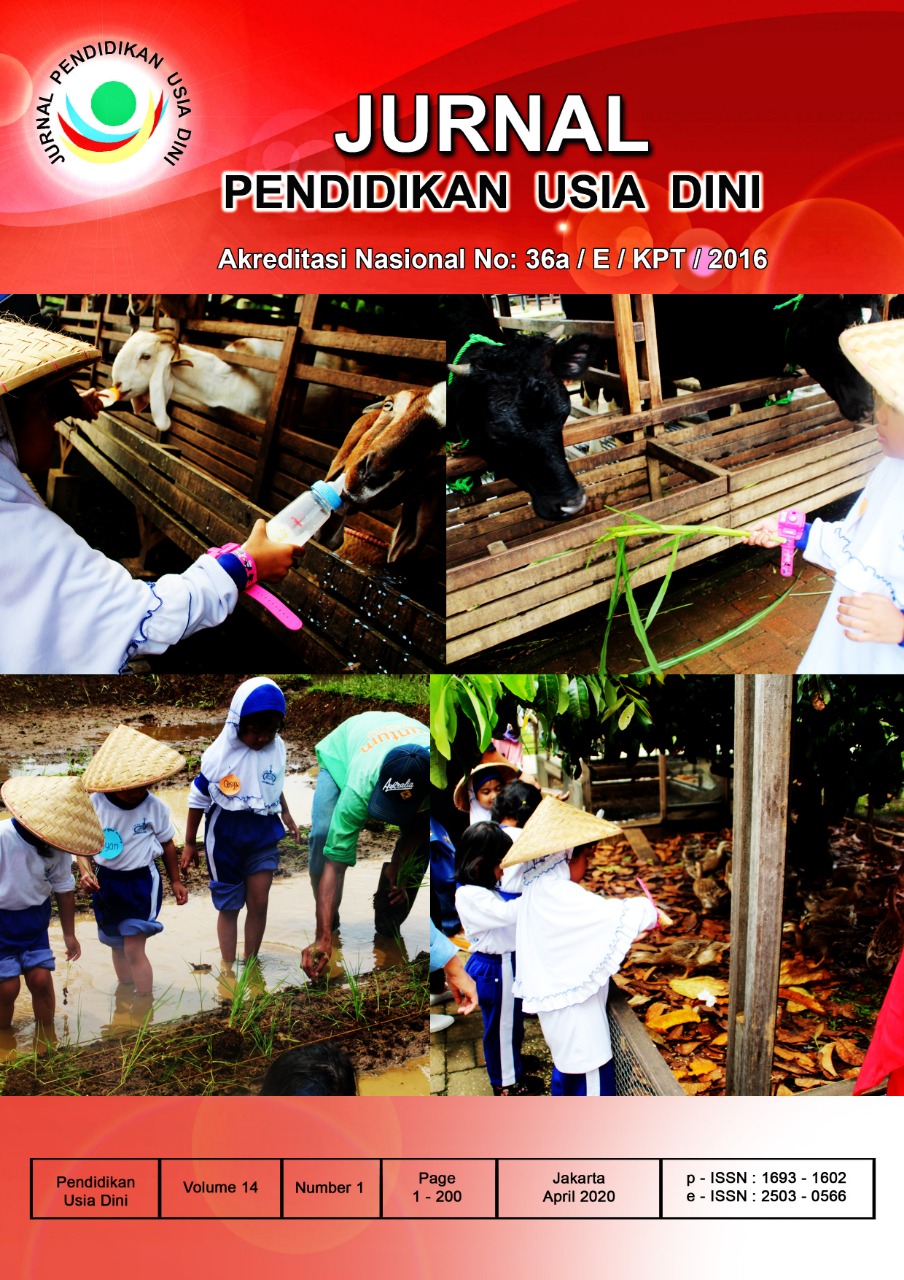Movie Media with Islamic Character Values to shaping “Ahlaqul Karimah" in Early Childhood
DOI:
https://doi.org/10.21009/141.13Abstract
ABSTRACT: Character education in Islam has its own style, as well as the character values con- tained in various learning media for early childhood. This study is a follow-up study to find the effect of Movie Media with Islamic Character Values (M-ICV) in shaping "Ahlaqul Karimah" in early childhood. Using an experimental method with a control class, which involved 19 respondents of early childhood. Data shows that the ttest < t table (0.75 < 2.110), meaning that there is a significant difference in effect between the experimental class and the control class. The results conclude that M-ICV is able to form a child's "Ahlakul Karimah" slowly, because the child likes various movies with content interesting and easy to imitate. The implications of further research on movie content development for children are able to develop other aspects of children's development.
Keywords: Early Childhood, Ahlakul karimah, Islamic Character Values Movie Media
References:
Al-Qardawi, Y. (1981). al-Khasais al-`ammah lil Islami [The general criteria of Islam]. Qaherah: Makatabah Wahbah.
An-Nawawi, Y. ibn S. (2000). Imam Nawawi’s Forty Hadith Yahya ibn Sharaf an-Nawawi. Ethiopia: Gondar.
Bae, B. (2012). Children and Teachers as Partners in Communication: Focus on Spacious and Narrow Interactional Patterns. International Journal of Early Childhood, 44(1), 53–69. https://doi.org/10.1007/s13158-012-0052-3
Balakrishnan, V. (2017). Making moral education work in a multicultural society with Islamic hegemony. Journal of Moral Education, 46(1), 79–87. https://doi.org/10.1080/03057240.2016.1268111
Budiningsih, C. A. (2004). Pembelajaran Moral: Berpijak pada Karakteristik Siswa dan Budayanya. Jakarta: Rineka Cipta.
Chalik, L., & Dunham, Y. (2020). Beliefs About Moral Obligation Structure Children’s Social Category-Based Expectations. Child Development, 91(1), e108–e119. https://doi.org/10.1111/cdev.13165
Danby, Susan, & Farrell, A. (2005). Opening the Research Conversation. In A. Farrell (Ed.), In Ethical Research with Children (pp. 49–67). Maidenhead: Open University Press.
Departemen Agama RI. (2007). Al-Qur’an dan Terjemahannya Al-Jumanatul’ali (pp. 1–1281). pp. 1–1281. Medinah Munawwarah: Mujamma’ Al Malik Fahd Li Thiba’ at Al Mush-haf.
Ebrahimi, M., & Yusoff, K. (2017). Islamic Identity, Ethical Principles and Human Values. European Journal of Multidisciplinary Studies, 6(1), 325. https://doi.org/10.26417/ejms.v6i1.p325-336
Embong, R., Bioumy, N., Abdullah, N. A., & Nawi, M. A. A. (2017). The Role of Teachers in infusing Islamic Values and Ethics. International Journal of Academic Research in Business and Social Sciences, 7(5). https://doi.org/10.6007/ijarbss/v7-i5/2980
Gopnik, A., & Wellman, H. M. (2012). Reconstructing constructivism: Causal models, Bayesian learning mechanisms, and the theory theory. Psychological Bulletin, 138(6), 1085–1108. https://doi.org/10.1037/a0028044
Halstead, J. M. (2007). Islamic values: A distinctive framework for moral education? Journal of Moral Education, 36(3), 283–296. https://doi.org/10.1080/03057240701643056
Hamdani, D. Al. (2014). The Character Education in Islamic Education Viewpoint. Jurnal Pendidikan Islam, 1(1), 97–109.
Herwina, & Ismah. (2018). Disemination of Tematic Learning Model Based on Asmaul Husna in Improving Early Childhood’s Religious Values at Ibnu Sina Kindergarten. Indonesian Journal of Early Childhood Education Studies, 7(1). https://doi.org/10.15294/ijeces.v7i1.20186
Ibn Anas, I. M. (1989). Al-muwatta (trans. A. A. Bewley). London: Kegan Paul International.
Letnes, M.-A. (2019). Multimodal Media Production: Children’s Meaning Making When Producing Animation in a Play-Based Pedagogy 180–195. London: Sage. In C. Gray & I. Palaiologou (Eds.), In Early Learning in the Digital Age. London: Sage.
Lovat, T. (2016). Islamic morality: Teaching to balance the record. Journal of Moral Education, 45(1), 1–15. https://doi.org/10.1080/03057240.2015.1136601
Mahmud, A. H. (2004). khlak Mulia, terjemahan dari al-Tarbiyah al-Khuluqiyah. Jakarta: Gema Insani Press.
McGavock, K. L. (2007). Agents of reform?: Children’s literature and philosophy. Philosophia, 35(2), 129–143. https://doi.org/10.1007/s11406-007-9048-x
Miskawayh, I. (1938). Ta╪dhib al-Akhlāq wa Ta╢hir al-‘Araq, ed. Hasan Tamim. Bayrūt: Manshūrat Dār al-Maktabah al- ╩ayat.
Narvaez, D., Gleason, T., Mitchell, C., & Bentley, J. (1999). Moral theme comprehension in children. Journal of Educational Psychology, 91(3), 477–487. https://doi.org/10.1037/0022-0663.91.3.477
Plowman, L., & Stephen, C. (2007). Guided interaction in pre-school settings. Journal of Computer Assisted Learning, 23(1), 14–26. https://doi.org/10.1111/j.1365-2729.2007.00194.x
Rahman, F. (1985). Law and ethics in Islam. In Ethics in Islam (R. G. Hova, pp. 3–15). California: Undena Publications.
Ramli. (2003). Menguak Karakter Bangsa. Jakarta: Grasindo.
Rhodes, M. (2012). Naïve Theories of Social Groups. Child Development, 83(6), 1900–1916. https://doi.org/10.1111/j.1467-8624.2012.01835.x
Rossiter, G. (1996). Science, film and television: An introductory study of the “alternative” religious stories that shape the spirituality of children and adolescents. International Journal of Children’s Spirituality, 1(1), 52–67. https://doi.org/10.1080/1364436960010108
Shihab, M. Q. (2001). Tafsîr al-Mishbâh. Jakarta: Lentera Hati.
Sukardi, I. (2016). Character Education Based on Religious Values: an Islamic Perspective. Ta’dib, 21(1), 41. https://doi.org/10.19109/td.v21i1.744
Tamuri, A. H. (2007). Islamic Education teachers’ perceptions of the teaching of akhlāq in Malaysian secondary schools. Journal of Moral Education, 36(3), 371–386. https://doi.org/10.1080/03057240701553347
udir.no/rammeplan. (2017). Framework Plan for Kindergartens (p. 64). p. 64. Norwegian: Directorate for Education and Training.
Walzer, R., & Gibb, H. A. R. (1960). Akhlak: (i) survey of ethics in Islam. In The encyclopaedia of Islam (H. A. R. G, p. 327). London, Luzac.
Wonderly, M. (2009). Children’s film as an instrument of moral education. Journal of Moral Education, 38(1), 1–15. https://doi.org/10.1080/03057240802601466
Downloads
Published
How to Cite
Issue
Section
License
JURNAL PENDIDIKAN USIA DINI work is licensed under a Creative Commons Attribution 4.0 International License. (http://creativecommons.org/licenses/by/4.0/)





